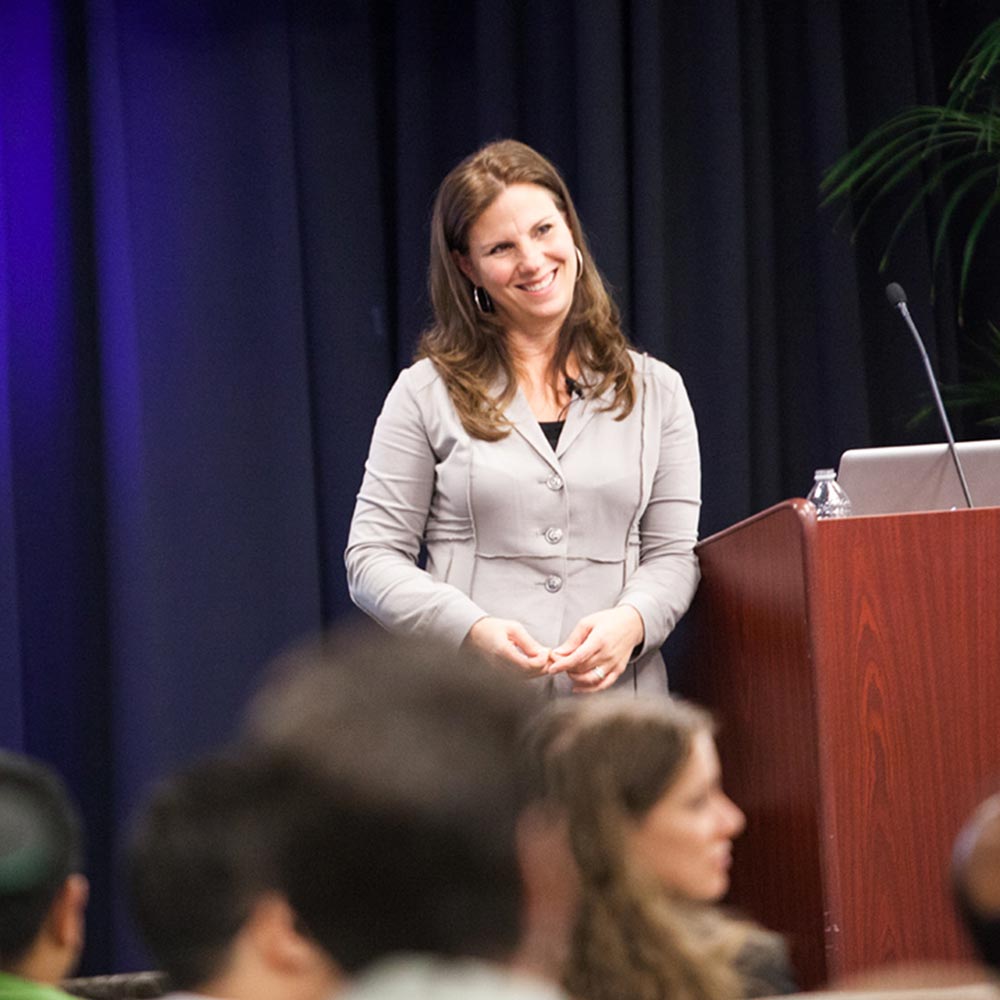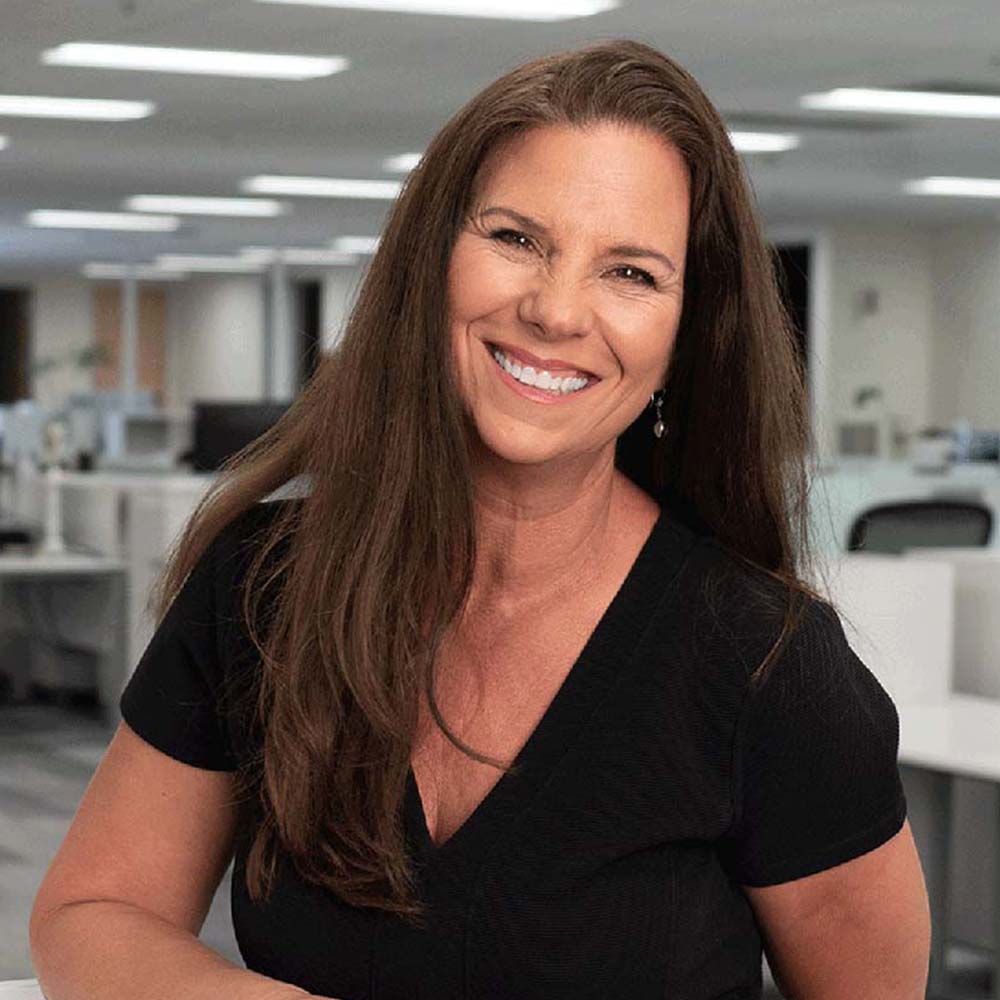
Reimagining event presentations to tell a visionary story
Hire a keynote speaker
Hire a speakerHire an engaging Duarte speaker for your next event.

“Never deliver a presentation you wouldn’t want to sit through.”
No lackluster presentations here. With our keynote speakers, you can inform, inspire, and align your team from one of our world-class communication experts.
We have a lot of keynote speakers to choose from – all are equally talented. Learn more about them below.

Some speakers are a challenge to work with. And some are downright terrible at communication! But there is No buyer’s remorse here! Our keynote speakers are easy to work with, and will partner with you to make sure your event is successful. Expert keynote talk topics include: Storytelling, persuasive communication, communication data, change communication, presentation design, presentation principles, Adaptive Listening™, visual storytelling, and more!
Chief Executive Officer
Nancy Duarte is author of six best-selling books and CEO of Duarte, Inc. For over 30 years, Duarte, Inc. has consulted and trained the highest performing brands and executives in the world. Duarte is a communication expert who has been featured in Fortune, Time Magazine, Forbes, Fast Company, Wired, Wall Street Journal, The New York Times, Cosmopolitan, Los Angeles Times, and on CNN. Her TEDx Talk has had over 3 million views. Nancy has received several awards for communications, entrepreneurship, and been honored for her achievements as a female executive. She’s ranked #67 on the list of top 250 Women in Leadership and is the #1 Global Communication Guru. Nancy lectures at Stanford University and her course Resonate is taught in the Stanford School of Business. As a persuasion expert, she cracked the code for effectively incorporating story patterns into business communications. Her favorite role is “Grandma” to two grandsons and grand-dogger.

Creative Director, Head of Design
Ryan Orcutt has been helping some of the world’s most influential speakers and top executives design and deliver compelling presentations for nearly two decades. He leads a department of more than 30 presentation experts and strives to uphold a high-level of creative output while maintaining a healthy, balanced, and diverse culture. A natural visual thinker, storyteller, and designer, Ryan’s skill lies in his ability to combine all three. As a Duarte Ambassador, Ryan speaks on the power and importance of presentations and believes that visual storytelling is an essential business communication tool. His extensive client list includes thought leaders like former Vice President Al Gore, Senator Elizabeth Warren, and Michael Pollan, and he’s built presentations for some of the biggest brands in the world, including Adobe, Apple, Blackberry, Cisco, Deloitte, Meta, Microsoft, Procter & Gamble, Rakuten, and Snap.

Senior Director, Communication Services
Maegan Stephens started earning her “10,000 hours” back when she was a competitive public-speaker in high school and college (yes, that’s a thing). From there, she sharpened her research skills with a PhD in Communication Studies from The University of Texas at Austin. She is the co-creator of the Adaptive Listening™ methodology and currently leads a team of Duarte, Inc. strategists, writers, and speaker coaches to transform the way people communicate.

Content Director, Executive Speaker Coach
Nicole Lowenbraun is a communication nerd who uses her unique speech-language pathology background – and decades of business acumen – to help clients excel in speaking, writing, and listening. With a Master’s in Communication Disorders, Nicole is passionate about fostering more inclusive communication in the workplace. She’s a Content Director at Duarte, Inc. and the proud co-creator of Adaptive Listening™ – the new gold standard for listening in the workplace.

Senior Director of Learning Strategy, Master Facilitator
With over 30 years at Duarte, Michael Duarte has held multiple roles, ranging from design to account services. In each role, he has used his love of problem solving to help his clients overcome their communications challenges. He uses his presentation design experience to help communicators become great visual storytellers. Michael is a faculty member for PopTech’s Social Innovation Fellows Program, a Communication Coach at UC Santa Clara’s Global Social Benefit Institute, and guest lecturer at Northwestern University. Michael has a BA in Psychology from CSU Chico, and completed the Management Development for Entrepreneurs program from UCLA’s Anderson School of Management. Work has taken Michael to 6 of the 7 continents – he just needs to visit Antarctica to complete all seven.

Academy Director, Master Facilitator
Kevin Friesen is a valued and sought-after ambassador of Duarte and our vision to transform people and organizations through unparalleled communication. For over 20 years, Kevin worked in the social sector developing people and programs to serve their communities. Since joining Duarte in 2011, Kevin has influenced thinking and promoted revolutionary change, leading over 700 workshops with hundreds of brands and thousands of individuals across the world. He helps awaken natural talents, build confidence, and drive influence in speakers and communicators of all experience levels. Kevin has a BA in Music and a Masters in Conducting from Golden Gate Seminary. He also completed the Executive Program in Social Entrepreneurialism from Stanford Graduate School of Business.

Chief Customer Officer
Becky Bausman draws on 20+ years of experience in C-level management consulting and enterprise marketing leadership to guide our clients’ own growth strategies. She applies her insights, agility and empathy to help business leaders build smart, impactful, scalable plans to transform their communication cultures and elevate the performance of their organizations. Becky joined Duarte in 2016 to shape our communication strategy practice, working directly with Fortune 50 leaders and their teams to craft messaging and communication plans that accelerate their change initiatives. Since then, she’s reimagined how Duarte serves its customers as head of our Client Services and Business Development teams. Becky quickly becomes a trusted advisor to everyone she meets, winning them over with her knockout combo of brilliance and warmth. A mom to two young boys, including one with special needs, Becky champions inclusion and brings joy wherever she goes.

Senior Director, Accelerator Lab™
Doug Neff is a writer, facilitator, trainer, and speaker coach with over fifteen years of experience moving people and audiences. Since joining Duarte in 2007, Doug has crafted award-winning presentations that influence mindsets, sell revolutionary products, and some are literally changing the world. As an Executive Speaker Coach, he has awakened natural talents, built confidence, and inspired passion in communicators of all experience levels.

Your organization is unique, and so are your needs. It’s time to get you a tailored talk from an expert keynote speaker.
When you hire a Duarte keynote speaker, you can rest easy. We do this kind of work for our clients, so we know how to take our own advice and leave a lasting impression.
We author the keynotes for the world’s biggest brands. We know a thing or two about writing great speeches.
We offer executive speaker coaching to the biggest events and top executives. We’ve been tested under pressure and high-stakes moments.
We’ve been doing this for 35+ years, and have experience with all audience sizes, mediums, and industries.

Whether you need a speaker for a mainstage event with thousands of attendees, or a breakout session for your company kick off, we can customize our talk and speaker for you.
Have existing content you want us to deliver? We can do that, too! Let’s partner together to give you the best keynote speaker and talk for your unique event.
Free resources
Check out these informative keynotes from our expert keynote speakers, dedicated to helping you overcome top presenting challenges